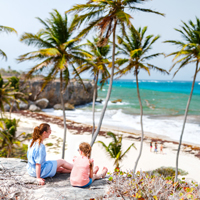Bohol Island, located in the Philippines, is a popular tourist destination known for its beautiful beaches, the Chocolate Hills, and the Tarsier Sanctuary. The island is also home to a variety of public transportation options that make it easy for both locals and tourists to get around. These include tricycles, jeepneys, buses, and taxis. There are also ferries that connect Bohol to other islands in the Philippines. With these options, it’s possible for an expat living in Bohol to comfortably live without a car, relying on the public transportation system and walking.
Tricycles
Tricycles are one of the most common forms of public transportation in Bohol. These are motorbikes with a sidecar attached, capable of carrying up to four passengers. Tricycles are a convenient way to travel short distances within towns and cities. They are also safe to use at any time of the day, even at night. However, they may not be the most comfortable option for long-distance travel. The cost of a tricycle ride varies depending on the distance, but it’s generally affordable. For example, a short ride within the city center may cost around 20 Philippine Pesos (approximately 0.40 USD).
Jeepneys
Jeepneys are another popular form of public transportation in Bohol. These are colorful, elongated jeeps that can carry up to 20 passengers. Jeepneys have specific routes that they follow, making them a good option for traveling longer distances within and between towns. They are also safe to use, even for women traveling alone or children going to school. The fare for a jeepney ride is also affordable, usually around 10 to 20 Philippine Pesos (approximately 0.20 to 0.40 USD) depending on the distance.
Buses
Buses in Bohol are mainly used for intercity travel. They are a reliable and safe way to travel between different towns and cities on the island. The buses are also comfortable, with some offering air conditioning and onboard entertainment. The fare for a bus ride depends on the distance, but it’s generally affordable. For example, a bus ride from Tagbilaran City to Anda, a popular beach destination on the eastern side of the island, costs around 100 Philippine Pesos (approximately 2 USD).
Taxis
Taxis are also available in Bohol, particularly in Tagbilaran City, the island’s capital. They offer a more private and comfortable way to travel compared to tricycles, jeepneys, and buses. Taxis are also safe to use at any time of the day. However, they are more expensive than other forms of public transportation. The fare for a taxi ride starts at 40 Philippine Pesos (approximately 0.80 USD), with an additional charge for every kilometer traveled.
Ferries
Ferries are an essential part of public transportation in Bohol, as they connect the island to other parts of the Philippines. There are regular ferry services between Tagbilaran City and Cebu City, Dumaguete City, and other nearby islands. The ferries are safe and comfortable, with options ranging from economy class to first-class cabins. The fare for a ferry ride varies depending on the destination and the class of service, but it’s generally affordable.
In conclusion, Bohol Island offers a variety of public transportation options that make it possible for an expat to live comfortably without a car. Whether you’re traveling short distances within a town or city, or going on a long-distance journey to another part of the island, there’s a public transportation option that suits your needs.

